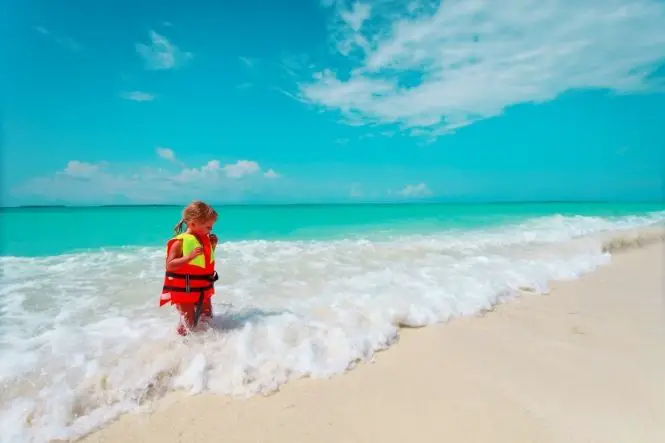Before going out to enjoy the beach this summer with your young children, you must keep in mind some of the basic safety practices. These include things like using the correct type of sunscreen and the right amount and going through swimming safety rules since swimming in an ocean or lake is different from swimming in a pool. Ensure you review this with your kids.
Going over swimming rules is probably an essential part of going to the beach with young children. While you should ensure that your children know how to swim correctly before going to the beach, also think about how swimming in an ocean or a lake is different from swimming in a pool. You should also consider the wildlife that your children could interact with while swimming.
You should also think about sun protection, which includes wearing the proper sunscreen and the correct amount and other gear like sunglasses and hats. You should also ensure that there are places with shade around the beach so that your child can sit and rest outside of direct sunlight. This can also help with any kind of heat exhaustion that might happen.
Table of Contents
How to Ensure Beach Safety for Young Child
Taking your children to the beach is a fun way to spend the summer while enjoying the cooling water and sunlight. However, a trip to the ocean requires you to go over some of the critical safety concerns to ensure an exciting and memorable outing without any close calls. This includes ensuring your child can swim adequately and protecting them from the Sun and other wildlife.
The following are some of the critical areas for you to educate yourself on and ensure that your child understands. Depending on how old they are, they may not understand all of the finer details but making it a routine to put on sunscreen or check-in with their parents is a good thing to build as a habit early on in life.
Protection from the Sun
Sunscreen is by far the best thing that you can use to protect your children while at the beach. You want to make sure that you’re using broad-spectrum waterproof sunscreen on all areas that will have sunlight. You want to use sunscreen that is at least SPF 15 for all six months or older children. Ensure that you are using enough sunscreen.
However, sunscreen isn’t the only thing you should be using to protect your children from the Sun. Ensure that they have sunglasses and a hat to help protect their eyes and face. Also, pick a beach where there are shady places so that your child can rest outside of direct sunlight. Avoid being in direct sunlight during the middle of the day.
Swimming Safety
Don’t let your younger children get anywhere near the water unless they are strong swimmers. You want them to swim correctly if they get anywhere near the water, but swimming in the ocean is a lot different from swimming in a pool. But in your child to get close to the Waterfront could result in a wave knocking them over or pulling them in with the tide.
Ensure that you always have an eye on your child while they are at the beach and that they have a swimming buddy with them that is a strong swimmer and can help them if anything goes wrong. Using life jackets is also a good thing since sometimes the tides and waves can be stronger than they might seem.
Stay Hydrated
Always bring water with you while you’re at the beach since you’re going to be in hot conditions and the like they are going to spend a lot of time in the sunlight. Having water that you can keep cool in a cooler of some kind is a great way to avoid dehydration and any type of heatstroke. Ensure that you are reminding your kids to drink water.
It’s also essential that you have some food that you have access to. Foods have many ways of helping the body generate after doing a lot of activity or being out in sunlight, but it also has water in them. Either bring foods that are non-perishable and survive being out in the warmer climate all day or pick a beach with food nearby.
Educate About Marine Life
What is how swimming in a lake or the ocean is different from swimming in a pool is that there will be more wildlife around. This is especially true with the sea, where jellyfish could be swept in with the tide. Educate your child about what animals could be around and emphasize avoiding them.
Think about where you are swimming and when. During twilight hours in the ocean, swimming could be dangerous because of sharks, especially if you have a cut that could start bleeding. You should avoid any kind of murky water or places where fishing takes place you should avoid as it could have different types of wildlife to avoid or something in the water you don’t want your kid exposed to.
Follow the Lifeguard’s Rules
All areas that are for swimming have a lifeguard. There are usually instructions posted somewhere around where the lifeguard is watching over those at the beach. Ensure that your child understands who the lifeguard is and go over the rules with a lifeguard has. You may even be able to talk with the lifeguard about some basic Beach safety rules.
The most important is that lifeguards tend to use flags or signs to warn visitors about tide conditions or some other issue with the safety of going into the water. You should make sure that your child can understand these indicators and look for them. If you don’t know these signals yourself, you must learn them.
Conclusion
The best thing to prepare for beach safety with your young children is to go over some basic things before you get to the beach. This includes ensuring that your child is a strong swimmer and that they understand that the water in the ocean or a lake will be different from swimming in a pool. Ensure your children stay close in a new setting.





